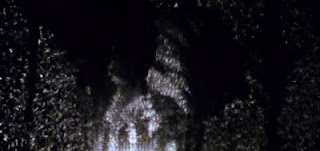
Radiators clang while spheres and cypridina phosphoresce. A rubber ball held up to light becomes a snowy crystal. Home science experiments and other attempts to see with the camera in the dark.
things we want to see (Rebecca Meyers 2004)

An introspective work that obliquely measures the fragility of life against boundless forces of nature, such as Alaskan ice floes, the Aurora Borealis and magnetic storms. -Mark Webber, London Film Festival
lions and tigers and bears (Rebecca Meyers 2006)
In lions and tigers and bears, Rebecca Meyers focuses on the urban wild
 life, both real and simulated, with which we share our cities. The most unlikely creatures somehow survive in a hostile environment, while animals are also invoked in artworks, corporate logos and other icons. Pets and animal icons testify to a human longing for proximity to wildlife, while the urban landscape offers its fugitive creatures artificial substitutes for the tree limbs and tunnels of the wild - Toronto International Film Festival Program Notes
life, both real and simulated, with which we share our cities. The most unlikely creatures somehow survive in a hostile environment, while animals are also invoked in artworks, corporate logos and other icons. Pets and animal icons testify to a human longing for proximity to wildlife, while the urban landscape offers its fugitive creatures artificial substitutes for the tree limbs and tunnels of the wild - Toronto International Film Festival Program Notesnight side (Rebecca Meyers 2008)

A side of the universe turned away from the sun. -RM
night side is a tone poem of twilight images, colors, and lights that privilege isolation, even loneliness. Birds appear alone, perched sentinel-like on winter branches. Interiors, though absent of human presence, nevertheless beckon through warmly lit reflections of lamps in windows. –Tony Pipolo, Millennium Film Journal
blue mantle (Rebecca Meyers 2010)

And now I roll with drifting currents, the prey
of fishes:
and this gravestone lies
If it says that it marks the place of my burial.
—Leonidas of Tarentum
Say, sea,
Take me!
—Emily Dickinson
Throughout the time when sea-going vessels were the primary means for “bringing man nearer unto man”, whether by means of fish alongside trawlers or tea in clippers, the 40 mile stretch of sea between Chatham and Provincetown, MA, came to be known as an ocean graveyard due to the many thousands of wrecks that occurred there. One, the Frances, which sank in 1872 can still be seen at low tide. The region is steeped in stolid New England history and awash with apocryphal tales immortalized in shanties that grow ever more potent as the mists of time fold in over the details. Blue Mantle is an elegantly composed work which combines these aspects with haunting cinematography. Historical account, literary texts, song and compositional fragments all make this film poem, a documentary of sorts, a soaked ships log, its pages already running with ink.